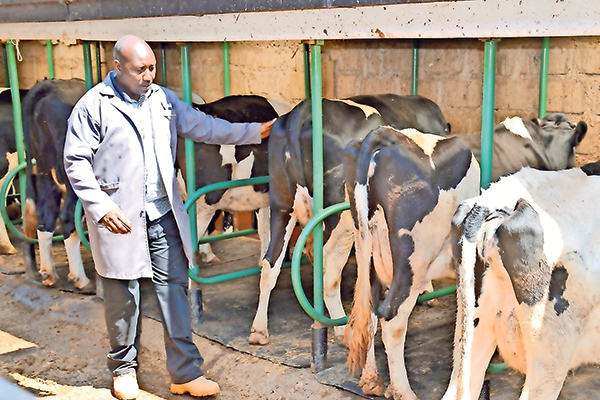Dairy Farms in Kenya: This feature was first published by the Saturday Nation: Gita Farm hosts 74 dairy cows. This dairy farm is owned by Evans Gitau, who is a former tout and matatu driver. A majority of the cows now average milk production of about 30 litres. The farm has been built in a manner that shows the farmer’s determination to make it one of the best dairy farms in Kenya.
Gitau has been in the dairy industry for the past eight years, raising the number of his herd from four to the current 74. “I collect over 750 litres of milk a day from 45 lactating cows. I deliver the milk to Githunguri Dairies, the company that makes Fresha milk products. They buy at between Sh. 36 and Sh. 38 depending on the market trends,” he says.
This means that in a good month, he can get a gross of Sh. 810,000 from the 750 litres he gets daily if he sells at a price of Sh. 36 per litre.
Gitau also has a history. He dropped out of primary school and did menial jobs in the village before becoming a tout and a driver along the Githunguri-Kiambu-Nairobi route and in Eastleigh and Dagoretti, working for four years. He says he quit in 2001 due to police harassment.
Farming on 1 acre; How Kiambu couple makes over Sh. 4 million.
The first-born in a family of seven, he returned home to help his widowed mother take care of her four cows and his responsibility was to feed them and deliver raw milk to Githunguri Dairy Co-operative Society.
He later quit, citing poor pay, and returned home in 2011 where he decided to concentrate on dairy farming, which was already flourishing after the establishment of the co-operative society.
“I presented a proposal to the sacco, which is owned by farmers, and I was advanced Sh. 240,000 to buy three Friesian cows. I disposed of the others that were on the farm,” he recalls, adding that milk output increased significantly, enabling him to repay the loan.
In 2013, he used the title deed of their family land to borrow Sh. 2 million and bought 17 Holstein Friesian cows from local farmers at Sh. 100,000 each. The animals were between two and six months in-calf.
With the balance, he leased a 10-acre farm in the neighbouring Kiambaa sub-county where he farmed napier grass and maize for silage preparation.
“The cows delivered 13 heifers and four bulls, increasing milk production from 50 litres to 150 litres per day. This enabled me to repay the loan,” says Gitau, who is currently building another farm.
With his herd increasing on the 100 by 100 feet land that also doubled up as the family home, Gitau had no choice but to look for a bigger space.
“I applied for a Sh. 4 million loan to facilitate expansion. I bought a 100 by 100 feet land at Sh. 1.2 million and built modern cowsheds using steel, concrete and tiles. I relocated the animals, built houses for the workers and installed a biogas system to manage manure.”
The farm currently hosts Holstein Friesian, Ayrshire and Fleckvieh breeds, 45 of which are lactating, 25 are heifers, most of which are in-calf, and the rest are calves. The top producers offer 40 litres a day and the least 15.
He delivers the milk to a collection centre using three-wheeler vehicles (tuk tuk). Once the animals calve down, he expects his milk production to hit 1,300 litres per day.
He has a 12-feet-deep and 40-feet-long silage bunker where he stores the feed to last him a year. Besides silage, he also offers the animals hay, dairy meal, napier grass and machicha — a brewer’s waste sourced from beer manufacturers.
“The animals consume at least 30 bags of silage, 35 bales of hay and napier each day. At 4am, we offer them a mixture of silage, hay, napier grass and each a bucket of machicha,” he says.
At around 11am, when preparing second round of milking, each animal gets two buckets of dairy meal and a bucket of machicha while at 6pm during the third milking, the animals get another bucket of feeds. The animals are washed and scrubbed with clean water twice a week. The barns are cleaned thrice a day. Dairy Farms in Kenya.









This statement isn’t adding up 2buckets of dairy meal in a day and another bucket of machicha
plus fodder -priduction cost is high not unless you meant a 2kg container… each animal gets two buckets of dairy meal and a bucket of machicha while at 6pm during the third milking, the animals get another bucket of feeds
Hi
Can I get his contact number please
Good venture for the youth looking for elusive jobs. Keep it up
Assist me with his contact
Good job but NO contacts